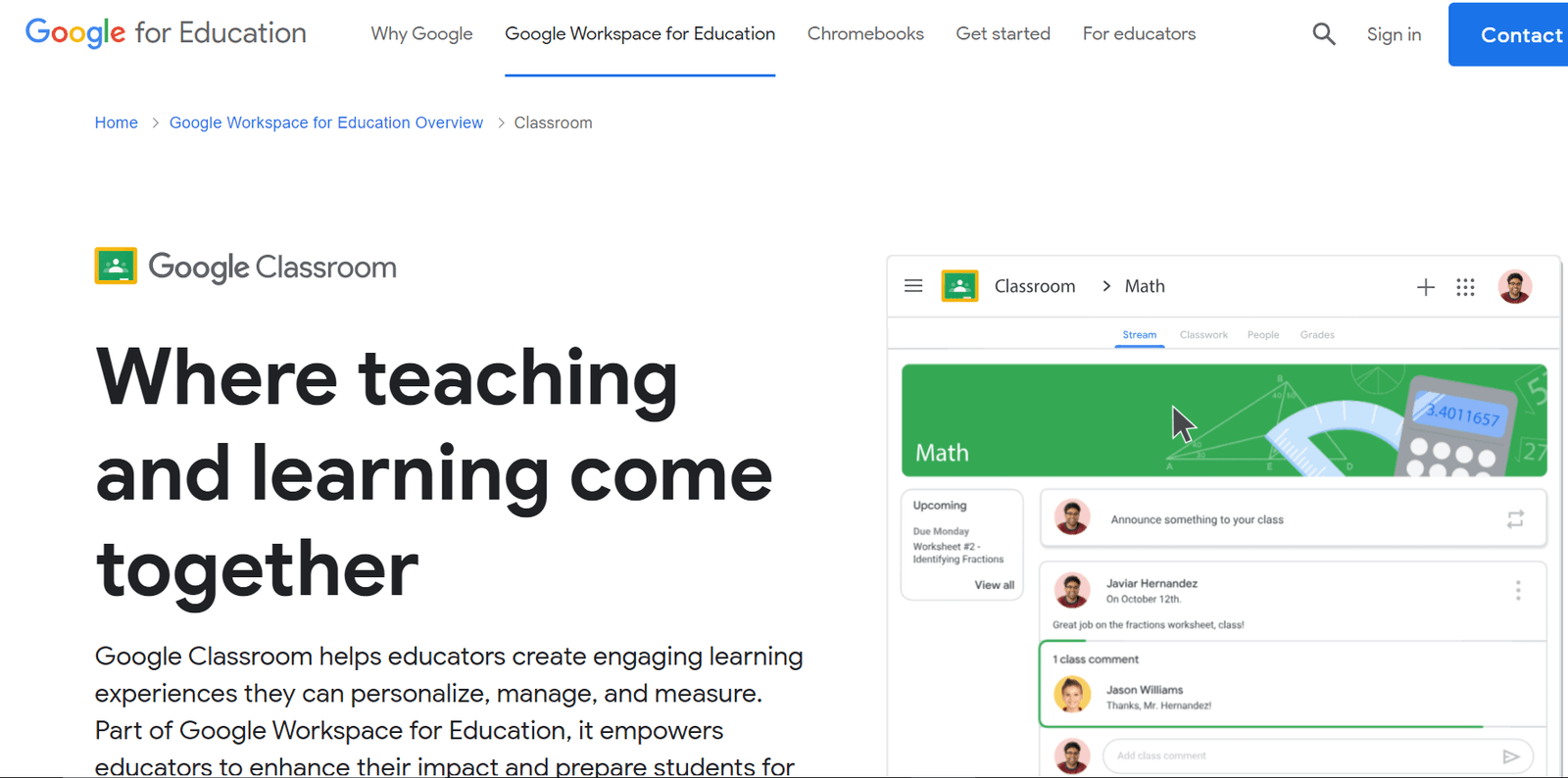
In the rapidly evolving landscape of education, technology has played a pivotal role in transforming how students learn and teachers teach. Among the myriad of tools available, Google Classroom has emerged as a cornerstone for modern educational practices, offering a seamless, integrated platform that bridges the gap between traditional and digital learning. This article delves into the genesis, features, impact, and future prospects of Google Classroom, highlighting its role in shaping the future of education.
The Genesis of Google Classroom
Google Classroom was launched in August 2014 as part of Google’s G Suite for Education. The platform was developed to simplify the process of creating, distributing, and grading assignments in a paperless environment. It aimed to streamline educational workflows and foster better communication between teachers and students. Since its inception, Google Classroom has continuously evolved, incorporating feedback from educators and adapting to the changing needs of the educational landscape.
Core Features of Google Classroom
Google Classroom is renowned for its user-friendly interface and a plethora of features designed to enhance the educational experience. Below are some of the core features that set Google Classroom apart:
1. Simplified Assignment Management
One of the primary functions of Google Classroom is to simplify assignment management. Teachers can create and distribute assignments with ease, set deadlines, and provide feedback all within the platform.
Key Features:
- Assignment Creation: Teachers can create various types of assignments, including essays, quizzes, and projects. These can be tailored to meet specific learning objectives.
- Distribution and Collection: Assignments are automatically distributed to students and collected upon completion, eliminating the need for physical handouts.
- Feedback and Grading: Teachers can provide real-time feedback and grade assignments directly in Google Classroom, streamlining the assessment process.
2. Integration with Google Workspace
Google Classroom seamlessly integrates with other Google Workspace tools such as Google Docs, Sheets, Slides, and Drive. This integration enhances collaboration and ensures that all educational resources are easily accessible.
Benefits of Integration:
- Collaboration: Students can collaborate on documents, spreadsheets, and presentations in real-time, fostering teamwork and collective learning.
- Resource Accessibility: All assignments and resources are stored in Google Drive, making it easy for students to access their work from any device.
- Enhanced Productivity: Integration with Google Calendar allows students to keep track of assignment deadlines and class schedules, improving time management.
3. Communication and Engagement
Google Classroom includes various communication tools that facilitate interaction between teachers and students. This feature is crucial for maintaining engagement and ensuring that students receive the support they need.
Communication Tools:
- Class Stream: The class stream acts as a central hub for announcements, discussions, and updates. Teachers can post important information, and students can ask questions and engage in discussions.
- Private Messaging: Teachers can send private messages to individual students, providing personalized support and feedback.
- Video Conferencing: Integration with Google Meet allows for virtual classes and meetings, ensuring that learning continues even in remote settings.
4. Customization and Accessibility
Google Classroom offers various customization options to cater to different educational needs and preferences. Additionally, the platform is designed to be accessible to all students, including those with disabilities.
Customization Options:
- Class Themes and Layouts: Teachers can customize the appearance of their classes with different themes and layouts, creating an engaging learning environment.
- Assignment Settings: Teachers can customize assignment settings, including deadlines, point values, and submission formats, to suit their teaching style.
Accessibility Features:
- Screen Reader Compatibility: Google Classroom is compatible with screen readers, ensuring that visually impaired students can navigate and use the platform effectively.
- Keyboard Shortcuts: The platform supports keyboard shortcuts, making it easier for students with motor disabilities to interact with the content.
The Impact of Google Classroom on Education
Since its launch, Google Classroom has had a profound impact on the educational landscape, influencing how teachers deliver instruction and how students engage with learning materials. Here are some of the key ways in which Google Classroom has made a difference:
1. Enhancing Teaching Efficiency
Google Classroom streamlines various administrative tasks, allowing teachers to focus more on instruction and student support. The platform’s automation features reduce the time spent on tasks such as distributing assignments, collecting submissions, and grading.
Case Study: A high school teacher in California reported that Google Classroom reduced her administrative workload by 30%, allowing her to dedicate more time to lesson planning and one-on-one student support.
2. Promoting Student Engagement
The interactive features of Google Classroom promote active learning and student engagement. The platform’s communication tools enable continuous interaction, while the integration with Google Workspace encourages collaborative learning.
Example: A middle school in Texas implemented Google Classroom and observed a 25% increase in student participation in online discussions and collaborative projects, leading to improved academic performance.
3. Facilitating Remote Learning
The COVID-19 pandemic highlighted the importance of remote learning tools, and Google Classroom played a crucial role in ensuring the continuity of education during school closures. The platform’s robust features supported teachers and students in transitioning to online learning environments.
Impact During Pandemic: Schools worldwide adopted Google Classroom to facilitate remote learning, allowing millions of students to continue their education despite the disruptions caused by the pandemic.
4. Supporting Differentiated Instruction
Google Classroom enables teachers to differentiate instruction by providing tailored assignments and resources to meet the diverse needs of students. The platform’s flexibility allows for personalized learning experiences that cater to individual strengths and areas for improvement.
Differentiated Instruction: An elementary school teacher in New York used Google Classroom to create differentiated assignments for her students, resulting in a more inclusive and effective learning environment.
Future Prospects of Google Classroom
As education continues to evolve, Google Classroom is poised to play an increasingly significant role in shaping the future of learning. Here are some of the key areas of focus for the future development of Google Classroom:
1. Advanced Analytics and Insights
Google Classroom is exploring the integration of advanced analytics and insights to provide teachers with deeper understanding of student performance and engagement. These insights will enable data-driven decision-making and personalized instruction.
Future Features:
- Performance Dashboards: Comprehensive dashboards that provide real-time data on student progress, participation, and performance.
- Predictive Analytics: Tools that use machine learning to identify students at risk of falling behind and suggest targeted interventions.
2. Enhanced Collaboration Tools
To further support collaborative learning, Google Classroom plans to introduce enhanced collaboration tools that facilitate group work and peer interaction.
Collaboration Enhancements:
- Group Projects: Features that allow students to form groups, work on projects collaboratively, and track group contributions.
- Peer Review: Tools that enable students to provide feedback on each other’s work, fostering a culture of peer learning and continuous improvement.
3. Expanded Integration with Third-Party Tools
Google Classroom aims to expand its integration with third-party educational tools and platforms, providing a more comprehensive and connected learning ecosystem.
Integration Plans:
- LMS Integration: Seamless integration with Learning Management Systems (LMS) to provide a unified platform for all educational activities.
- EdTech Tools: Partnerships with educational technology providers to offer a wide range of tools and resources within Google Classroom.
4. Focus on Equity and Inclusion
Google Classroom is committed to ensuring that its platform is accessible and inclusive for all students, regardless of their background or abilities. Future developments will focus on enhancing accessibility features and supporting diverse learning needs.
Inclusion Initiatives:
- Multilingual Support: Expanded support for multiple languages to cater to non-English speaking students and educators.
- Accessibility Enhancements: Ongoing improvements to accessibility features, ensuring that all students can fully participate in the learning process.
FAQs
Can students join a Google Classroom without an invitation?
Answer: Yes, students can join a Google Classroom using a class code provided by the teacher. The teacher can generate and share this code, which students can use to join the class.
Can Google Classroom integrate with other Google Workspace tools?
Yes, Google Classroom seamlessly integrates with other Google Workspace tools such as Google Docs, Sheets, Slides, Drive, Calendar, and Google Meet. This integration enhances collaboration and resource management.
Is Google Classroom free to use?
Yes, Google Classroom is free for educational institutions. However, additional features and services are available through Google Workspace for Education Fundamentals, Standard, Teaching and Learning Upgrade, and Education Plus, which may come with costs.
How does grading work in Google Classroom?
Teachers can grade assignments directly within Google Classroom. They can provide numeric grades, add comments, and return assignments to students. The platform also supports rubrics for detailed grading criteria.
How secure is Google Classroom?
Answer: Google Classroom follows strict security and privacy guidelines. It complies with FERPA (Family Educational Rights and Privacy Act) and COPPA (Children’s Online Privacy Protection Act), ensuring that student data is protected.
Can Google Classroom be used for remote learning?
Yes, Google Classroom is highly effective for remote learning. It supports virtual classes through Google Meet, provides a central hub for resources, assignments, and communication, and allows for flexible learning environments.




